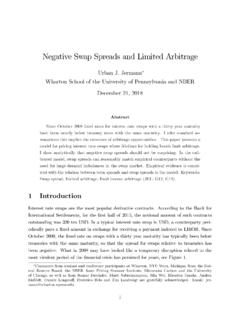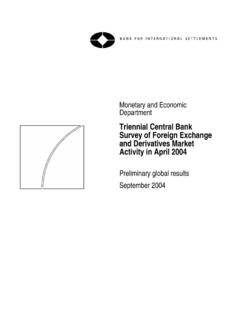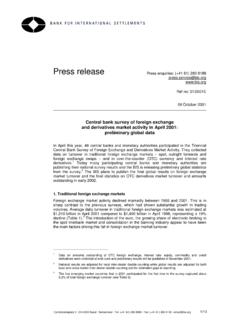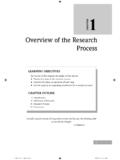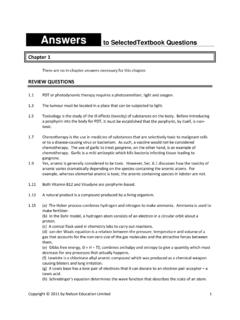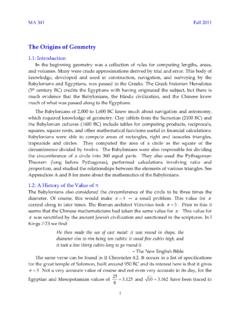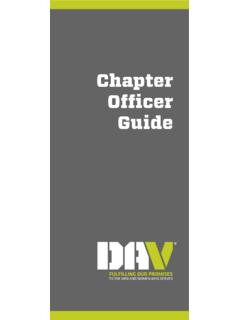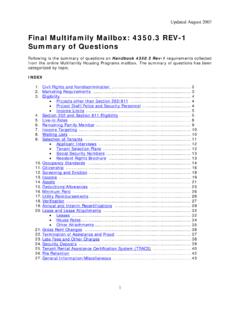Transcription of CHAPTER 3 BALANCE OF PAYMENTS SUGGESTED …
1 CHAPTER 3 BALANCE OF PAYMENTS . SUGGESTED answers AND SOLUTIONS TO END-OF- CHAPTER . QUESTIONS AND PROBLEMS. QUESTIONS. 1. Define the BALANCE of PAYMENTS . Answer: The BALANCE of PAYMENTS (BOP) can be defined as the statistical record of a country's international transactions over a certain period of time presented in the form of double-entry bookkeeping. 2. Why would it be useful to examine a country's BALANCE of PAYMENTS data? Answer: It would be useful to examine a country's BOP for at least two reasons. First, BOP provides detailed information about the supply and demand of the country's currency. Second, BOP data can be used to evaluate the performance of the country in international economic competition. For example, if a country is experiencing perennial BOP deficits, it may signal that the country's industries lack competitiveness.
2 3. The United States has experienced continuous current account deficits since the early 1980s. What do you think are the main causes for the deficits? What would be the consequences of continuous current account deficits? Answer: The current account deficits of may have reflected a few reasons such as (I) a historically high real interest rate in the , which is due to ballooning federal budget deficits, that kept the dollar strong, and (ii) weak competitiveness of the industries. 4. In contrast to the , Japan has realized continuous current account surpluses. What could be the main causes for these surpluses? Is it desirable to have continuous current account surpluses? Answer: Japan's continuous current account surpluses may have reflected a weak yen and high competitiveness of Japanese industries.
3 Massive capital exports by Japan prevented yen from appreciating more than it did. At the same time, foreigners' exports to Japan were hampered by closed nature of Japanese markets. Continuous current account surpluses disrupt free trade by promoting protectionist sentiment in the deficit country. It is not desirable especially when it is brought about by the mercantilist policies. 5. Comment on the following statement: Since the imports more than it exports, it is necessary for the to import capital from foreign countries to finance its current account deficits.. Answer: The statement presupposes that the current account deficit causes its capital account surplus. In reality, the causality may be running in the opposite direction: capital account surplus may cause the country's current account deficit.
4 Suppose foreigners find the a great place to invest and send their capital to the , resulting in capital account surplus. This capital inflow will strengthen the dollar, hurting the export and encouraging imports from foreign countries, causing current account deficits. 6. Explain how a country can run an overall BALANCE of PAYMENTS deficit or surplus. Answer: A country can run an overall BOP deficit or surplus by engaging in the official reserve transactions. For example, an overall BOP deficit can be supported by drawing down the central bank's reserve holdings. Likewise, an overall BOP surplus can be absorbed by adding to the central bank's reserve holdings. 7. Explain official reserve assets and its major components.
5 Answer: Official reserve assets are those financial assets that can be used as international means of PAYMENTS . Currently, official reserve assets comprise: (I) gold, (ii) foreign exchanges, (iii) special drawing rights (SDRs), and (iv) reserve positions with the IMF. Foreign exchanges are by far the most important official reserves. 8. Explain how to compute the overall BALANCE and discuss its significance. Answer: The overall BOP is determined by computing the cumulative BALANCE of PAYMENTS including the current account, capital account, and the statistical discrepancies. The overall BOP is significant because it indicates a country's international payment gap that must be financed by the government's official reserve transactions.
6 9. Since the early 1980s, foreign portfolio investors have purchased a significant portion of treasury bond issues. Discuss the short-term and long-term effects of foreigners' portfolio investment on the BALANCE of PAYMENTS . Answer: As foreigners purchase Treasury bonds, BOP will improve in the short run. But in the long run, BOP may deteriorate because the should pay interests and principals to foreigners. If foreign funds are used productively and contributes to the competitiveness of industries, however, BOP may improve in the long run. 10. Describe the BALANCE of PAYMENTS identity and discuss its implications under the fixed and flexible exchange rate regimes. Answer: The BALANCE of PAYMENTS identity holds that the combined BALANCE on the current and capital accounts should be equal in size, but opposite in sign, to the change in the official reserves: BCA + BKA.
7 = -BRA. Under the pure flexible exchange rate regime, central banks do not engage in official reserve transactions. Thus, the overall BALANCE must BALANCE , , BCA = -BKA. Under the fixed exchange rate regime, however, a country can have an overall BOP surplus or deficit as the central bank will accommodate it via official reserve transactions. 11. Exhibit indicates that in 1999, Germany had a current account deficit and at the same time a capital account deficit. Explain how this can happen? Answer: In 1999, Germany experienced an overall BOP deficit, which must have been accommodated by the central bank, , drawing down its reserve holdings. 12. Explain how each of the following transactions will be classified and recorded in the debit and credit of the BALANCE of PAYMENTS : (1) A Japanese insurance company purchases Treasury bonds and pays out of its bank account kept in New York City.
8 (2) A citizen consumes a meal at a restaurant in Paris and pays with her American Express card. (3) A Indian immigrant living in Los Angeles sends a check drawn on his bank account as a gift to his parents living in Bombay. (4) A computer programmer is hired by a British company for consulting and gets paid from the bank account maintained by the British company. Answer: _____. Transactions Credit Debit _____. Japanese purchase of T bonds . Japanese payment using NYC account . citizen having a meal in Paris . Paying the meal with American Express . Gift to parents in Bombay . Receipts of the check by parents (goodwill) . Export of programming service . British payment out its account in . _____. 13. Construct the BALANCE of payment table for Japan for the year of 2006 which is comparable in format to Exhibit , and interpret the numerical data.
9 You may consult International Financial Statistics published by IMF or research for useful websites for the data yourself. Answer: A summary of the Japanese BALANCE of PAYMENTS for 2006 (in $ billion). Credits Debits Current Account (1) Exports ( ) Merchandise ( ) Services ( ) Factor income (2) Imports ( ) Merchandise ( ) Services ( ) Factor income (3) Unilateral transfer BALANCE on current account [(1) + (2) + (3)]. Capital Account (4) Direct investment (5) Portfolio investment ( ) Equity securities ( ) Debt securities (6) Other investment BALANCE on financial account [(4) + (5) + (6)]. (7) Statistical discrepancies Overall BALANCE Official Reserve Account Source: IMF, International Financial Statistics Yearbook, 2008.
10 Note: Capital account in the above table corresponds with the Financial account' in IMF's BALANCE of payment statistics. IMF's Capital account' BALANCE is included in Other investment' in the above table. Investments in financial derivative assets are also included in other investment. It is noted that Japan experienced divestment' by foreigners in both direct investment and other investment categories in 2006. PROBLEMS. 1. 2000 BALANCE of PAYMENTS Solution: Merchandise BALANCE on current account BALANCE on capital account Statistical discrepancies .73. MINI CASE: MEXICO'S BALANCE OF PAYMENTS PROBLEM. Recently, Mexico experienced large-scale trade deficits, depletion of foreign reserve holdings and a major currency devaluation in December 1994, followed by the decision to freely float the peso.

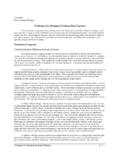

![Dif In Dif Slides.ppt [Repaired] - Wharton Finance](/cache/preview/e/2/9/5/4/6/1/8/thumb-e29546186543c246a2365bc5cbc8c9a4.jpg)
